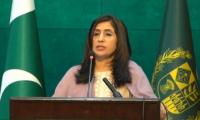ISLAMABAD: Pakistan’s remittances have surged by 26.5 percent, foreign direct investment (FDI) by 9.1 percent and tax revenues by 4.5 percent during the first four months (July-Oct) of the current fiscal year.
The country’s budget deficit rose to Rs484 billion or 1.1 percent of GDP in the first four months against Rs286 billion or 0.7 percent of GDP, so the budget deficit witnessed an upsurge by Rs198 billion in the current fiscal year so far.
The CPI based inflation stood at 8.9 percent so far while it was 10.3 percent in the same period of last fiscal year. Exports came down by 10.3 percent and imports reduced by 4 percent. The non-tax revenue slashed down by 15.2 percent.
According to the Economic Update released by Ministry of Finance on Friday despite making claims of economic recovery during the recent months, the government Friday conceded that the downside risks were becoming prominent by looking at the impact of the second wave of corona pandemic.
“Economic recovery, which started since the start of the new fiscal year, continued in the month of October 2020. However, looking at the impact of the ongoing coronavirus, the downside risks are becoming prominent. Most importantly, the recent increase in the number of coronavirus cases is forcing the government to follow partial careful policy especially in services sectors.
“Thus, like the rest of the world, the economic outlook for Pakistan is also having a mixed message,” the report stated. However, if the SOPs are strictly followed by the general public, it is expected the negative impact can be dampened and economy will return to long-term sustainable growth path, it further stated.
Talking about inflation, the Ministry of Finance said during Jul-Oct FY2021, the main drivers of inflation (CPI) in Pakistan are international and domestic commodity prices, especially for food and oil products, the exchange rate and monetary and fiscal policies. Supply disruptions and inflation expectations have also played major role in the determination of prices of food and non-food items.
In recent months, the international food prices have increased compared to last year while oil price is stable at a lower level. Further, the PKR exchange rate slightly appreciated against the USD when the first 4 months of 2020 are compared with the corresponding months of 2019. Thus, easing out inflationary pressures is expected.
There is no change in Indirect tax or other measures which may cause inflationary impact. Likewise, interest rate is kept unchanged. The CPI level reacts to the aforementioned developments with a time lag, implying that they contain relevant information for short term inflation prediction.
On the basis of this information, MoM headline inflation is expected to be around 0.9 percent in November (margin between -0.3 and +1.4 percent) against 1.7 percent in October 2020 and 1.45 percent in October 2019. YoY headline inflation in November is expected to settle around 8.5 percent (but within a broad uncertainty margin between 7.6 and 9.0 percent) compared to 8.9 percent in October 2020 and 11.0 percent in
October 2019. It seems that tendency of inflation easing will prevail in coming months. Agriculture: The prospects for growth in agriculture are encouraging on the basis of better production of sugarcane and rice. The government has announced “Rabi Package” which will encourage major and minor crops growers and it is expected that performance of agriculture will remain as per target or it may even surpass the target.
Industrial activity: Industrial activity, measured by the LSM index is the sector which is most exposed to external conditions. Its exposure to developments in international markets is illustrated in which compares the YoY growth rate of LSM with the weighted average Composite Leading Indicators in Pakistan’s main export markets (CLI). LSM index is published with a time lag of around two months, whereas CLI is published with a one-month lag.
The recent movements in LSM are coherent with the further economic expansion in the main trading partners, and with the deceleration. The Monthly Economic Indicator (MEI) is based on combining monthly data of indicators that are proven to be correlated with GDP at constant prices. The MEI is scaled to align with annual GDP growth. It is a so-called global method, implying that changing any point or adding points to the series will affect all points in the indicator (the same is the case with other international indicators such as the CLI calculated and published by the OECD).
It should be noted that some of the data underlying the October MEI are still provisional and may be revised next month. But based on available data, the MEI shows continued growth in October, in continuation with what was observed in the previous three months. It remains persistent as seen in first quarter of current fiscal year.
External: Sufficient orders are available with the exporters for the coming months and it is expected that the export sector will perform better in recovery. In November 2020, exports of goods and services are expected to reach around 2.3 billion US (but in a broad margin of 2.1 around 4.1 billion US$ (within a wide probability margin of 3.5 to 4.8 billion US Regarding remittances inflows deficit in goods and services.
Fiscal: Fiscal performance for Q1 FY 2021 was quite satisfactory however challenges still persist due to recent increase in number of corona virus cases. The government continues to concentrate on expenditures related to COVID, both for economic revival and social relief, so it can build pressure on the expenditure side and increase public spending.
On the revenues side, FBR tax collection performed better in the wake of activities during the first four months of current fiscal year. However, with the increase I COVID infection and related containment measures, slower economic activities in services sectors may slightly impact revenue collection in Q2
Regarding way forward, the report stated that Pakistan economy is underway of recovery. The MEI shows strong growth in the first four months of the current FY. Furthermore, based on current information, no significant deterioration in the balance of trade in goods and services is expected. Also, the inflow of workers remittances remains strong. Therefore, the recovery may preserve.
External balance implies the prospect for a stable exchange rate in the near term, which may contribute, in addition to specific Government measures, to reduce inflationary pressures.
A major risk to this scenario of economic recovery is the upsurge of COVID-19 infections, all over the world and also, to a lesser degree, in follows that economic growth year. Like governments in other parts of the world, Pakistan government is also intended to preserve the health of the people by imposing a number of restrictions in some sectors and areas of the economy.
The effects on the economic outlook will depend on the intensity and duration of these restrictions. But specific well-designed government policies may soften the economic burden of these necessary restrictions.
On the other hand, very recent world-wide communications regarding the production of several very successful new vaccines may open the scope for opening a back-to normal path in the near future. These developments may boost business and consumer confidence and further enhance economic growth, it concluded.
Kasuri urged authorities of Pakistan and China to pull their resources to defeat forces seeking to disrupt the...
IHC said that several people had not returned the cipher copies they had, and asked if it meant it was right for the...
Gilani gave floor to Leader of Opposition Syed Shibli Faraz, who insisted that with unity they could take country...
Match witnessed intense action and dramatic twists, keeping fans on the edge of their seats until the final ball
Apex court bench was reconstituted after Justice Yahya Afridi recused himself from hearing the case earlier this month
ECP issued a notification in this connection pursuant to orders passed by LHC







